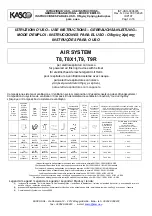
www.bullard.com
FAMB2 Half-Mask
Respirator System User Manual
7
Inspection, Cleaning and Stor
age
Inspection, Cleaning and Storage
This respirator and all of its components, parts and assemblies should be
inspected for damage or excessive wear before and after each use to ensure
proper functioning. Immediately remove the respirator from service and
replace parts or assemblies that show any sign of failure or excessive wear
that might reduce the degree of protection.
Use only complete NIOSH-approved Bullard FAMB2 components and
replacement parts on this respirator. Refer to the parts list for correct
part numbers.
The respirator should be cleaned, inspected and sanitized at least weekly
or more often if subjected to heavy use. Respirators used by more than
one person must be cleaned, inspected and sanitized after each use. If not
cleaned, contamination may cause illness or disease.
NOTE:
REMEMBER, THE AIR YOU BREATHE WILL NOT BE CLEAN UNLESS THE
RESPIRATOR YOU WEAR IS CLEAN.
Mask
Immerse the facepiece in warm water (about 120 degrees F) with mild
detergent or a germicidal disinfecting detergent. The respirator body and
parts may be scrubbed gently with a cloth or soft brush. All foreign matter
must be removed carefully from all surfaces of the exhalation valve flaps
and seats.
Wipe any areas still showing accumulations of foreign matter with a cloth
moistened in a detergent or a solvent such as mineral spirits or naphtha,
until clean.
More stubborn accumulations of paints, lacquers or enamels may be removed
with a cloth containing a paint, enamel or lacquer stripping agent. Once the
dirt or paint is loosened, it may be gently rubbed or brushed off.
�
WARNING
DO NOT use volatile solvents for cleaning this respirator or any parts and
assembles. strong cleaning and disinfecting agents, and many solvents,
can damage the silicone rubber and plastic parts. DO NOT leave solvents
and strong cleaning and sanitizing agents in contact with silicone rubber
or plastic surfaces any longer than necessary to loosen the accumulations
of dirt or contaminants.
Rinse the respirator in clean, warm water (about 120 degrees F). Shake to
remove excess water, and allow to air-dry away from direct heat, sunlight
or contaminants.
Breathing Tube
Inspection
Inspect the breathing tube for tears, cracks, holes or excessive wear that
might reduce the degree of protection originally provided. Be sure the
quick-disconnect fitting is screwed tightly into the breathing tube so no air
can escape.
If any signs of excessive wear are present, replace the breathing tube
assembly immediately or remove the respirator from service.
Cleaning
To clean the breathing tube assembly, hand-sponge with warm water and mild
detergent, rinse and air-dry. Do not get water inside the breathing tube. After
cleaning, once again carefully inspect breathing tube for signs of damage.
Air Supply Hose
Inspection
The hose(s) should be inspected closely for abrasions, corrosion, cuts, cracks
and blistering. Make sure the hose fittings are crimped tightly to the hose so
that air cannot escape. Make sure the hose has not been kinked or crushed by
any equipment that may have rolled over it.
If any of the above signs are present or any other signs of excessive wear are
detected, replace the air supply hose(s) immediately or remove the respirator
from service.
Cleaning
The air supply hose(s) should be hand-sponged with warm water and mild
detergent, rinsed and air-dried. Do not get water inside the air supply hose.
After cleaning, once again carefully inspect air supply hose(s) for signs
of damage.
�
WARNING
Only use hoses that are NIOSH approved for use with this respirator.
Other hoses could reduce airflow and protection, and expose the wearer
to life-threatening conditions.
Failure to observe these warnings could result in death or serious injury.
Storage
After reusable respirator components have been cleaned, dried compeletely
and inspected, place them in a plastic bag or an airtight container. Store
the respirator and parts where they will be protected from contamination,
distortion and damage from elements such as dust, direct sunlight, heat,
extreme cold, excessive moisture and harmful chemicals. Store the
respirator so it is protected from distortion from the weight or pressure of
surrounding objects.





















